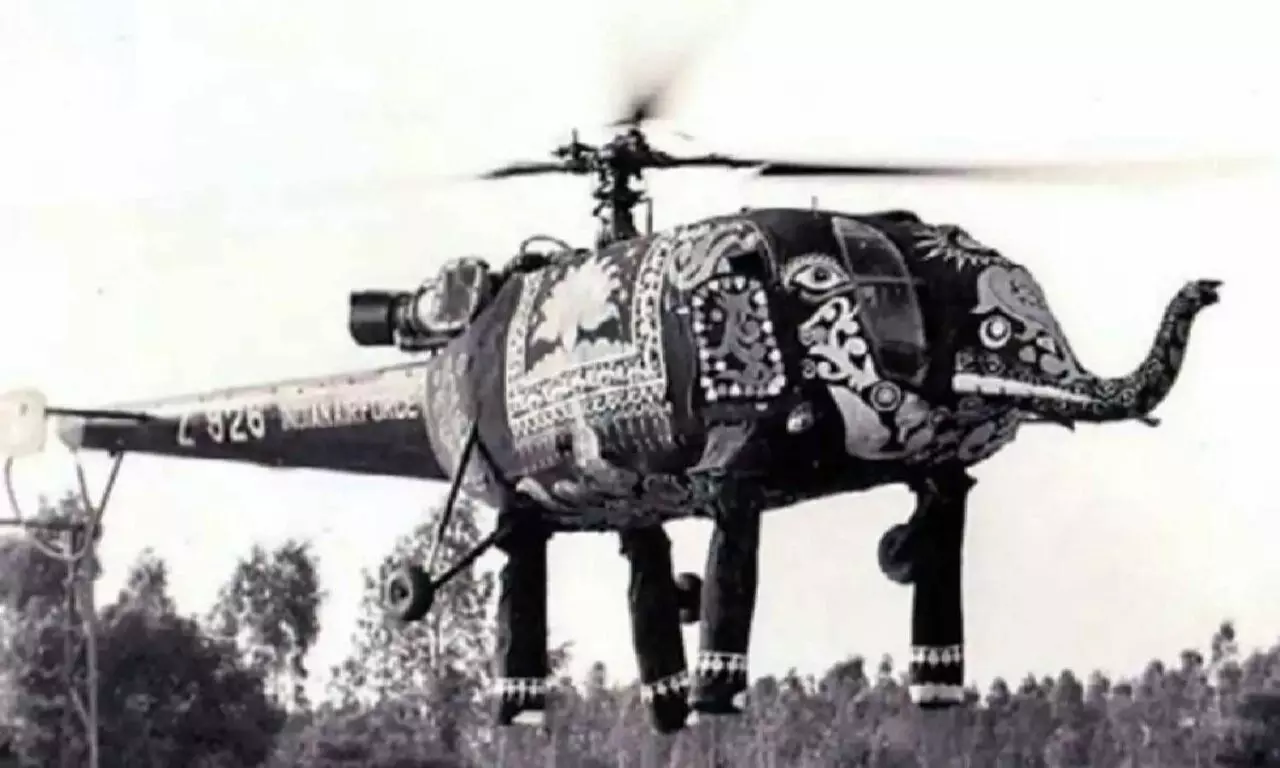60 years of HAL Chetak: French songbird turned Rajput warhorse
On festive occasions, it showered flower petals, dressed itself up to look like an elephant
By K.S Nair
Indian Army, Air Force, Navy, Coast Guard and Hindustan Aeronautics Limited (HAL) are all marking 60 years of the Chetak helicopter today. It is good to mark and celebrate the service of this invaluable flying machine, which has done so much not only operationally but also in training, and in familiarising three generations of engineers and support staff with the ways of the rotary wing. Many eye-popping statistics will no doubt be presented today, of numbers built (hundreds), flying hours logged (tens if not hundreds of thousands), and more.
For people "of a certain age" (including this writer) in India, the word "helicopter" almost immediately conjures up an image of the HAL Chetak. First inducted into the Indian armed forces in 1962 (let that sink in - in 1962!!), it has rendered yeoman service, over virtually all the many varied and demanding terrains over which our armed forces (and other essential services) operate. It was not quite the first helicopter operated by the Indian armed forces, but for many years it was the most numerous.
In its time with us, the Chetak led Republic Day flypasts, streaming the national flag and the IAF ensign. It delivered and evacuated personnel and light cargo in the desert, and from snowbound mountain locations to hundreds of locations in between, and to and from ships at sea. It ferried VIPs, as well as thousands of ordinary service people to numerous destinations with difficult environmental and safety demands. It landed and took off from semi-prepared locations (and in emergencies unprepared ones). Its engines inhaled dust, ice, leaves, and sand, depending on the conditions it was thrown into; and for the most part, they continued to operate with only mild complaints, and brought their riders home. It strapped on big, unwieldy floats, to provide helicopter services to offshore oil platforms. It even air-to-surface missile launchers, and anti-ship torpedoes, for grimmer attack roles.
And on festive occasions, it showered flower petals, dressed itself up to look like an elephant, and executed dance routines for delighted audiences of children as well as their parents. And sixty years after induction, close to two hundred Chetaks remain in active service, flown by crews often well over thirty years younger than the design of their steeds.
The HAL-built Chetak is named, as we all know Maharana Pratap's legendary horse. In Rajput court poems, retold in Lt Col James Tod's classic Annals and Antiquities of Rajasthan, Chetak carried the Maharana to safety after the Battle of Haldighati. It is a good name, for a flying machine that has carried out numberless rescue and casualty evacuation missions.
The original French design, of which the Chetak is a license-built Indian version, was the Sud Aviation (now Aerospatiale) Alouette, which means "lark", the widely-distributed and cosmopolitan songbird, known for its elaborate calls and tuneful songs. The evolution from skylark to warhorse is not a bad symbol, for a machine that has discharged so many wonderfully supportive functions, and can on occasion turn its rotors to more warlike pursuits!
But for all the well-deserved accolades which will be showered on the HAL Chetak today and beyond, for those concerned about India's defence, emergency preparedness, and the safety of the personnel carrying out those functions, some uncomfortable questions need to be asked. The Chetak is an aircraft – a machine in a demanding industry, in which machinery failures or operating errors can have fatal consequences. Safety expectations, and the behavior of operators and maintainers today, are all very different from what they were six decades ago.
At 60 the Chetak is already twenty years older than the equally widely-used MiG-21 was when it began to be viewed with alarm, for the (not entirely accurate) public perception of its safety challenges. While the overall safety record of the Chetak in Indian service is not in question (and may that always remain true), the design is beginning to show its age. There have been more accidents in the last decade or so than those concerned should be comfortable with. And yet, nearly two hundred of these venerable machines continue as workhorses in India, which can only be replaced by another, more modern helicopter.
The Indian defence public sector has to its credit some excellent newer indigenous helicopter designs – the Dhruv, originally the Advanced Light Helicopter or ALH, and its many derivates, as well as the Light Utility Helicopter and the Light Combat Helicopter. These are all, as currently specified, capable of operating at the high altitudes and extremes of temperature that India's armed forces need. (These parameters exceed by some margin the standard specifications of most American and European helicopters, with some exceptions.) But order placement and production rates from Indian sources have, to put it as politely as possible, been excruciatingly slow.
Without entering into arguments about which of the many stakeholders is responsible for the slow production, it is a fact that in recognition of our inability to deliver quickly enough, the last NDA government agreed to import and build around 200 Russian Ka-226Ts (to be substantially built in India) – back in 2015. Seven years on, that agreement has not fructified, apparently because of disagreements over indigenization and, inevitably, cost. There must be larger questions about its practicability today.
So while we celebrate the Chetak – which it fully deserves – would it be too much to ask (with all due respect, and full acknowledgment of their demonstrable decisiveness) for the leaders of our country to bang a few heads together and do whatever it takes to ensure we do not "celebrate" the 70th anniversary of the Chetak in Indian service, with several examples still soldiering on in the Indian armed forces?